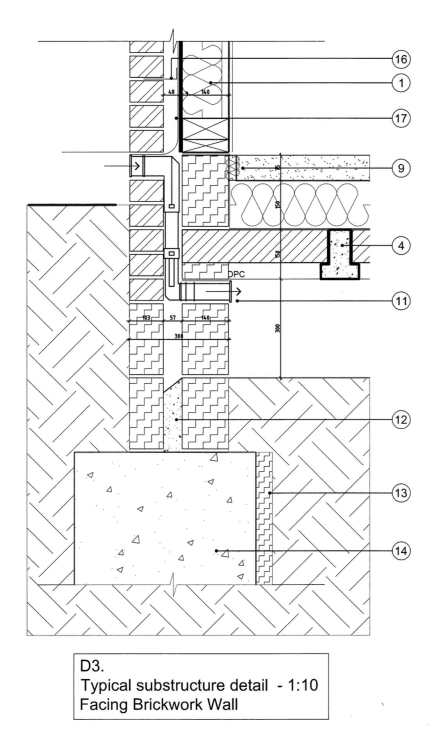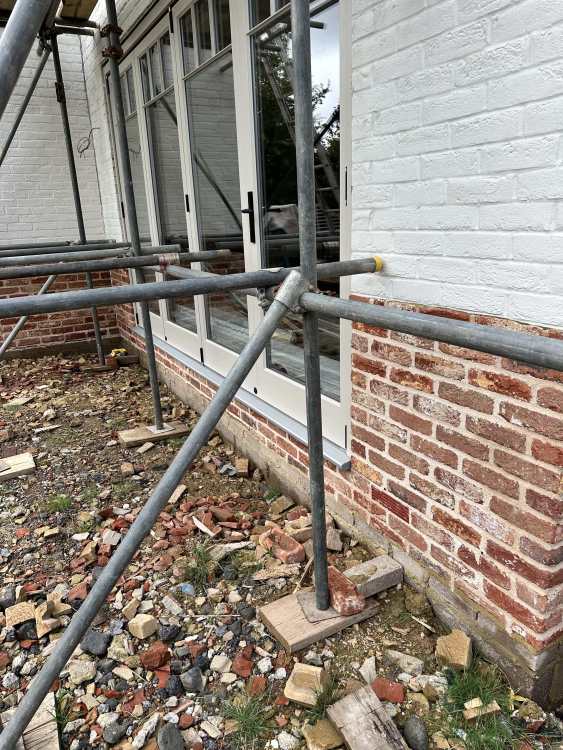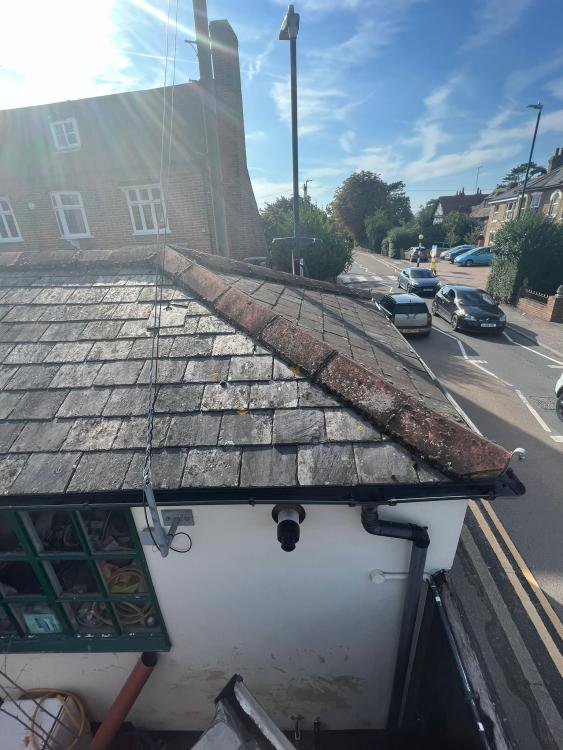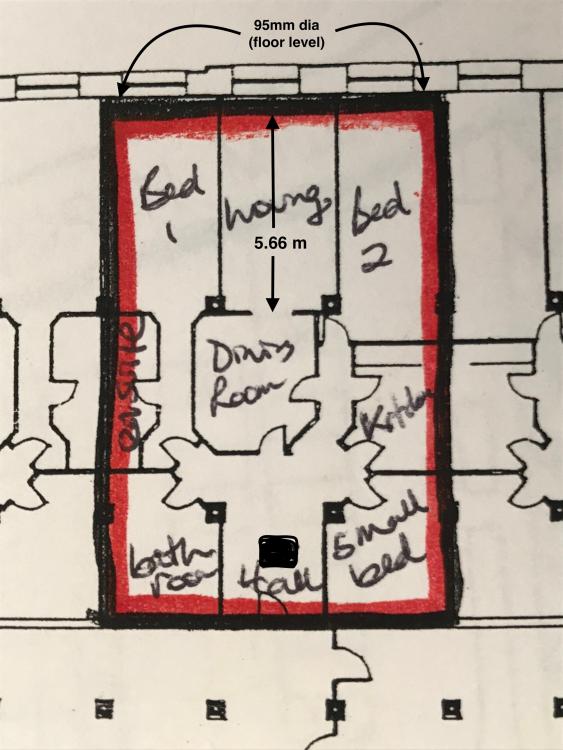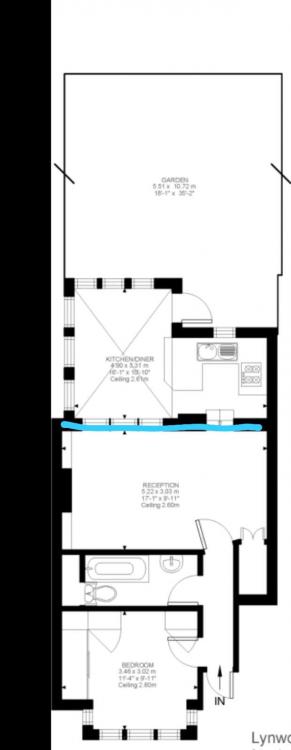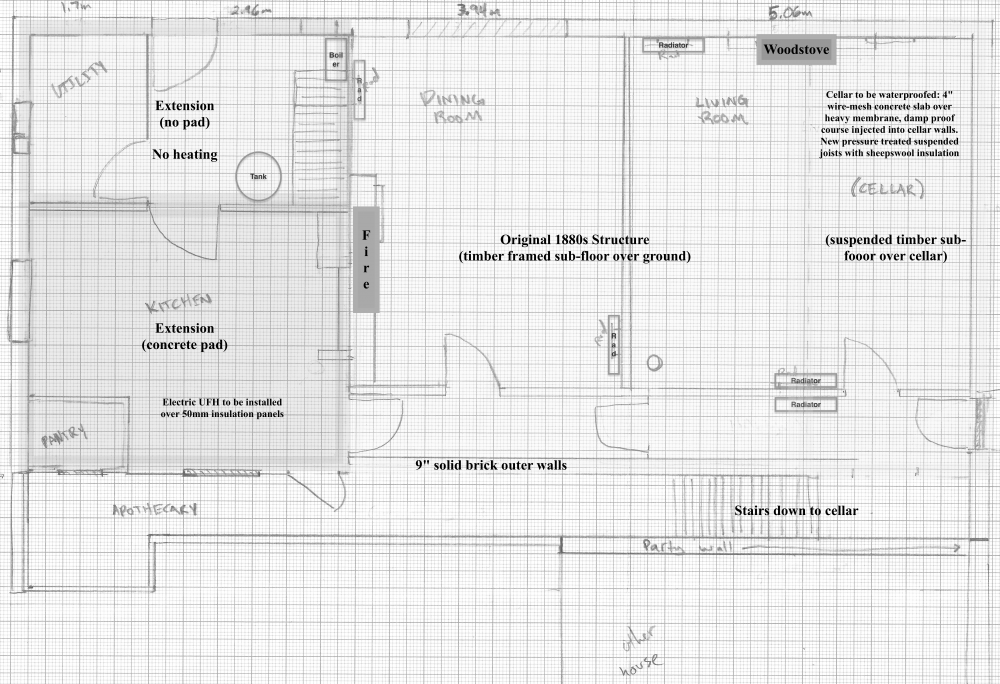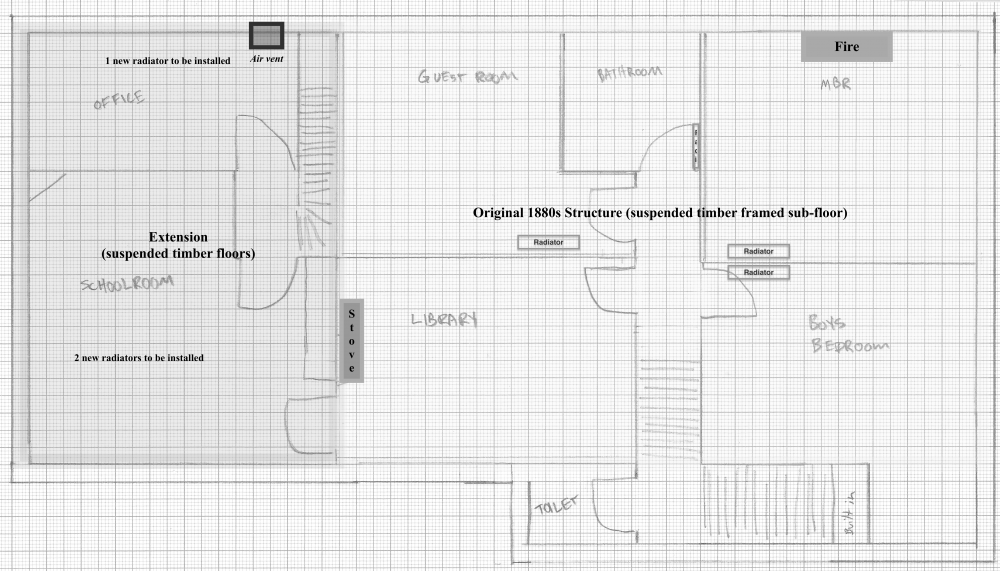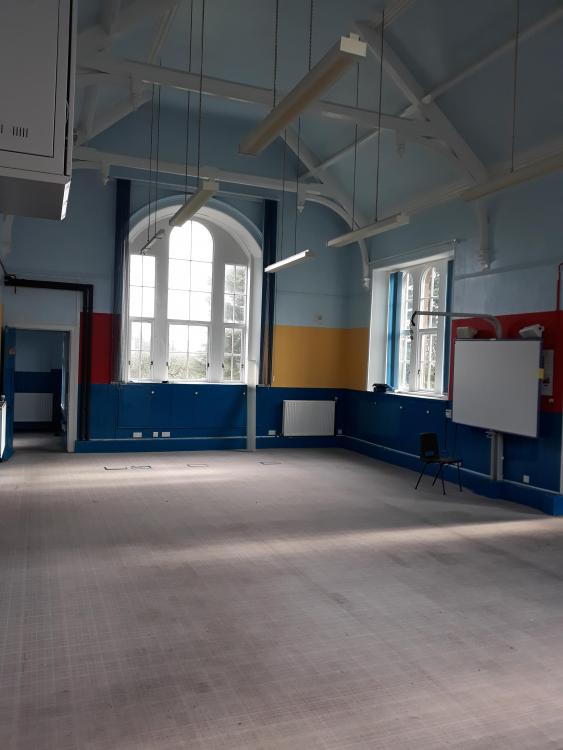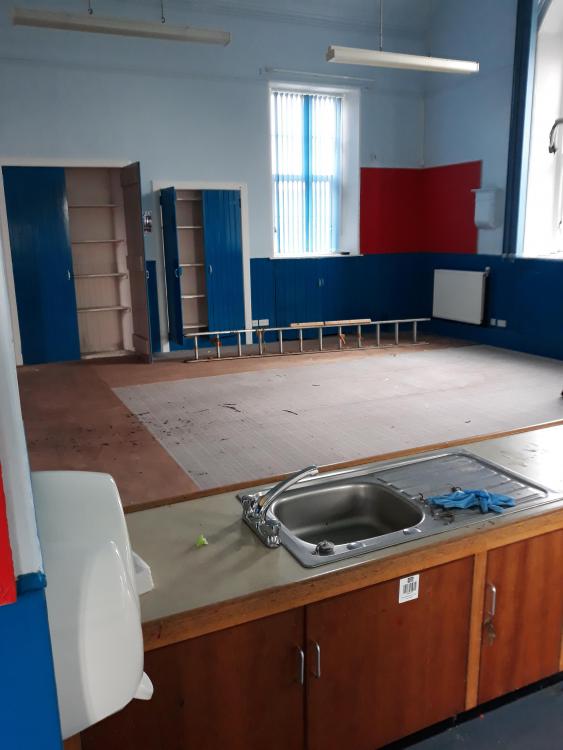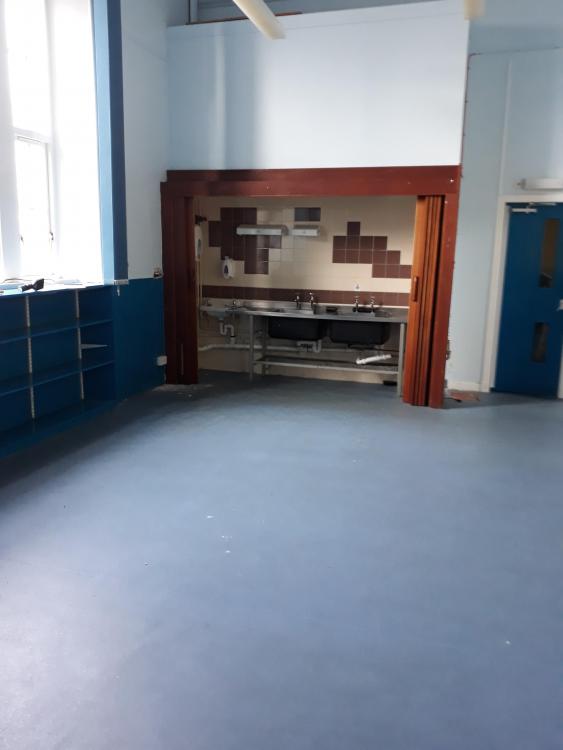Search the Community
Showing results for tags 'ventilation'.
-
Ages ago I wrote a spreadsheet for doing what-if comparisons to see whether it was better to invest in more insulation in the walls, roof, floor, fit better windows and doors, or fit a better MVHR system. Others have found it useful and I've been reminded that I've not re-posted it over here, so here's the latest version. It should be self-explanatory, you fill in the cells with your wall, roof/ceiling and floor areas, add the areas of each door and window, put in the U values for each and, if you can, get hold of the met data from the met office for your area (the data in there is for West Wiltshire, right on the border with Dorset). This isn't a thorough modelling tool, it just looks at heat loss fairly accurately but doesn't take into account heat gains, although there is a crude way of doing that by drawing a line across the seasonal plot at the point where you don't use heating and you can very roughly assume that anything above that line will be heating. Please feel free to ask any questions, but bear in mind I wrote it back when I was designing our house and haven't used it for a couple of years. so I may be a bit rusty. Heat loss calculator - Master.xls [edited to add latest version of the spreadsheet]
- 142 replies
-
- 10
-

-

-
- heat loss
- ventilation
-
(and 4 more)
Tagged with:
-
I'm unsure if this is best posted in Boffins corner or MVHR being ventilation heat loss related. When planning my self-build heating and ventilation system, I've learned a lot of things, but some are a little out of my grasp to fully understand. It's very theoretical and I'm unsure how some of it plays out in the real world. So, I'll post what I have, and see if anyone with a good understanding of it all can advise me or correct anything I'm wrong with. You can over size or undersize a heating system, but undersizing is a more of a concern to me, especially with under floor heating pipe spacings. The property will be 200m2, masonry cavity wall construction. Without going into every sealing detail I've researched, I'll be applying a lot of attention to airtightness and aiming for the lowest score I can. I'd like to achieve 2ACH @50PA if possible and will have MVHR installed. I've completed a heat loss survey using some popular software, & tried various things to see how it impacts the end result. Being a self-build, I've been lucky enough to obtain the exact U values for all of the construction materials I'll be using, from the manufacturers, but there's still a couple of things that could have a large affect on my total heat loss. My maximum heat loss will be 5.7Kw, this includes me selecting the exposed area tick box to all rooms with an outside wall. I believe this adds 10% on, so if I removed it, the property could be 5.1 Kw I selected it to air on the side of caution with it being detached and 3 miles from the NW coast in the lake district, where the wind and rain can be heavy at times. I was told that this has less impact on properties with good levels of airtightness, should I leave it on or remove it? Airtightness: The heat loss software defaults most rooms to 0.5 ACH, except, Kitchen 1.5 ACH Toilet 1.5 ACH Bathrooms 1 ACH I believe 0.5 ACH derives from the worst case air pressure test result to obtain a pass. Building regs lowest pass limit was 10 ACH@50 PA, (Now apparently 8 ACH) which is terrible, I'd expect an average new build to be around 5, higher standard 2 ACH, and passive house 0.6 ACH. 10 ACH @50PA / 20 = 0.5 ACH. Is 20 the correct figure to divide by? If I achieved 0.2 ACH @50PA / 20 = 0.1 ACH. This lower air change per hour, input to the heat loss software would severely reduce my property heat loss. Without trying it yet, I'd guesstimate to be 3.5Kw which I'd not feel confident was realistic. If I should reduce the ACH from 0.5, how much do you scale the other rooms by with higher values? Do I play it safe and leave the ACH at their defaults, and if wrong, at least it's consistent for all rooms. Once the MVHR design is complete, their room by room air flow rates will likely affect this again, which I've glanced at, but one step at a time. The MVHR designer doesn't factor in heat loss and heat engineers don't factor in MVHR ventilation rates.
- 19 replies
-
Our under ground vents were designed by our architect to sit externally a course below the finished internal floor height, and this is what was built. See attached drawing and picture. We are now onto the patio, and want our patio level to be the same as our finished internal floor, ie no step down, however if we do this we will block the vents! What is the solution? Our landscaper says the vents should be above the floor level. Our builder and architect say all new build under floor vents are positioned like this…
- 1 reply
-
- groundworks
- ventilation
-
(and 2 more)
Tagged with:
-
I am installing external wood fibre insulation between adjustable wooden joists on the external wall. There will then be a membrane, counter battens, horizontal battens, and vertical larch cladding. At the head of window/door reveals, standard advice is to use a flashing to drain any water at base of ventilated space behind cladding (e.g. https://woodcampus.co.uk/wp-content/uploads/2022/07/9DetailOpenings-vert14-1-15.pdf). In my case, the 240 mm deep joists require closing at base at the head of the reveal, and battens are required to take the larch lining of the reveal head. The only way I can think of doing this is summarized in the attached sketch (hope it is understandable). The cavity behind the vertical larch cladding is vented at bottom and top, but the space between battens at the head of the reveal is only vented beneath the flashing. I can't think of any other way of doing this. If anybody has any alternative suggestions, I would love to hear them. Thank you. Window reveal head.pdf
-
Howdy. I have a cold north facing office room (2.2m wide by 2.2m long) which has a pitched ceiling thats 3.6m at it's peak. The ceiling has pine cladding and under that is some pastic sheeting then insulation roll. Looking at the heat calcs if I made the ceiling flat (say 2.4m) I would need a lot less heating in the room. If I used an insulated plasterboard with vapour layer would I need ventilation in the void that would created between the old pine ceiling and and the flat roof? Any advice on this would be great thanks
- 2 replies
-
- pitched
- insulation
-
(and 1 more)
Tagged with:
-
Looking for some advice on roofing if I may: I’m building a cabin with cold roof in SW UK and concerned about the air gap between insulation and OSB deck. The roof comprises (inside to outside): 12mm Q mark plywood Thick vapour barrier (black DPM) that is fitted best I could but without butyl tape to seal screw holes and stapler holes. 170mm deep rafter filled with 150mm PIR insulation which only gives me a 20mm air gap (50mm is recommended building regs). I messed up the materials order. That’s where I’ve paused building. Roof is 10 degrees single pitch roof Spans 4.2 meters I’ve already ordered 32/1000mm box profile metal roofing sheets High usage holiday cabin I can see 3 options going forward: A) No OSB on top of rafters - just membrane, counter battens then metal roofing Q) is this weather proof enough? Warm enough? Too much airflow? B) OSB fixed to rafters (20mm air gap), breather membrane, cross batten then metal box profile roofing. Gaps on front fascia and eaves for airflow. Q) enough airflow? 50mm is most people's recommendation. C) option B but with battens on top of rafters to lift OSB and increase air flow (cross and through ventilation) Q) is this too much airflow?) Any advice or thoughts much appreciated. I know cold roofs are prone to moisture build up so I want to get this right. Cheers, Jake
-
We are looking to convert our detached garage into living accomodation. It's part of a Grade II listed building so maintaining the exterior appearance is very important. The current structure is timber rafters, membrane and natural slate. Plan is to deepen the rafters by attaching 50mm timber battens and insulate between and below the rafters with PIR leaving a 50mm ventilation gap. I have wide soffits which I can use to provide an inlet for ventilation but I am wondering how I can provide an exhuast at the ridge without altering the external appearance (which means that ridge vents are out of the picture). Any ideas greatly appreciated.
- 20 replies
-
- ridge board
- ventilation
-
(and 1 more)
Tagged with:
-
Hi all, we’re looking at a multi fuel burner installation with this set up as the starting point: The bungalow was built in the 80’s, the fire is vented underfloor straight to the bottom of the deep box which holds the ash fallout. The actual fire is not large enough to take a burner, but there is room in front of it. My thoughts were to block the front of the fire place, run a flue through the plate and a little way up the chimney. The fire is a 8kw, to go in a large living room. I’m thinking new legislation may make this idea obsolete so I’m asking for suggestions. thanks in advance
-
- log burner
- ventilation
-
(and 1 more)
Tagged with:
-
Hi everybody. I've been searching for some input and advice on my MHRV system online, and noticed this very helpful site. My wife and I built our house about 5 years ago, and have a loft mounted Regavent Air Unit 600 DC R fitted, and it is this system that we're seeking some input and advice on. Having experience a few warm summers, and having finally read the manual in detail we have learnt more about what the standard 'Summer' mode actually does - namely switch the incoming air supply OFF to allow windows to be opened, rather than provide a bypass to the incoming air heat exchange. Fair enough. However, the ability to have cooler air (i.e. with no heat recovery active) distributed via the system is attractive, not least due to keeping noise, bugs and dust out in the evenings and nights. So, having also learnt that the bypass function was then, and is still now an option (which we would have likely chosen at the time had we been more aware), we're assessing whether this is a possibility to be fitted as an after market solution. The Regavent does not list this as being available as a retrofit - in fact the 'Shop' options do seem pretty limited, suggesting that the company wants to only sell components if they can be sold with a fitting option. Checking back on our old quotations, the bypass was listed as an option but was not costed - again suggesting that some components may have a variable price depending on the deal being struck. Appreciate if anyone on the forum has had any experience of having the bypass option added as an after market fit, either by having Regavent in, by purchasing the equipment themselves or even having a 3rd party system fitted. Many thanks.
-
Hi, I am in the middle of building a timber-frame house (awaiting first fix electrics and plumbing). The recent hot spell has convinced me to get brise-soliel on the south facing upstairs windows. I have them planned for downstairs already. But I played around with PHPP and although my overheating reduced it didn't disappear. My phpp consultant has no figures inputted for L31 window ventilation air change rate and P59 Window night ventilation (in summer vent sheet) Has anyone got 'typical' figures for these? I have used 0.35 and 0.15 respectively and my overheating drops down to 3.9% (with all southern windows shaded). Apart from fitted brise-soliel there isn't much else I can do as all doors windows are fitted and insulation is in place - so I just want to check if the ventilation figures are reasonable. Thanks
- 14 replies
-
- shading
- brise soleil
-
(and 3 more)
Tagged with:
-
Hi there. This is my first post on the buildhub. I'm a halfways capable DIY-er, with more mistakes behind me than successes, but I learn. My current problem is the ventilation of my sons' bedrooms. Do you think you can help please? The window in each room has no trickle vent. Please see the attached photos. I do have a sliding vent above each bedroom into the hall. With 3 boys sharing two rooms, a lot of moisture and smell is generated overnight. I am not keen on leaving the windows open overnight, due to draughts and security. After watching a DIY video explaining how to retro-fit a trickle vent in a DG window, I drilled a pilot hole in one window frame, expecting a short penetration into void space within the frame that could likewise be accessed from the other side. Instead I hit something solid - possibly metal reinforcement within the frame. Anyways it looks like trickle vents are out, unless you can advise on what I might be doing wrong with the window frame, or perhaps suggest another means, e.g. through the brick wall? I'm concerned in any case these vents are passive and largely uncontrollable. They are also subject to clogging and the effects of wind and other weather stuff. Buildhub led me to the idea of PIV. I have plenty accessible space in my loft and easy access to gable ends, but not much money. I suspect they are expensive? I have two bathrooms, a kitchen and a living room, as well as 3 bedrooms to be involved in PIV. Do you think that might be a solution? What are the limitations? Can I DIY the installation? I also read about MVHR. Do you think that could work? Again, I don't have much money, what are the limitations? Can I DIY the installation? I read that this solution is dependent on air tightness levels of 5ach or below (air changes per hour). No idea how I can measure that. Do you know? A few questions here. Apologies. I hope you can provide some good advice that will help me. Ay. James.
- 9 replies
-
- ventilation
- piv
-
(and 3 more)
Tagged with:
-
Hi there. I've recently bought a 1970s build bungalow. The majority of rooms do not have trickle vents in the double-glazed windows. I've joined this hub to seek some advice and guidance on the best way to ventilate my sons' bedrooms. With doors closed at night, and 3 teenagers sharing two rooms, a lot of moisture (and smell!) is generated and I'd like them to have fresh air circulating in their rooms.
-
The builder is taking a rest... I've lost trust and am checking everything as it's all down to me now.. The rafters are 200mm. The original spec of the vaulted being was 200mm of sheeps wool, BUT we had to then change to F1 bituminous roofing membrane, non breathable, because of the bats and so was encouraged to change to PIR 150mm and a 50mm gap. Fair enough. However, I need to understand the detailing. On the SE diagram the steels are outside the thermal envelope, except for the one resting on the internal wall. (NB the vaulted ceiling will be the whole area, the diagram is slightly wrong as the design was amended, it seems to me that the vertical steel could go in or out of the thermal envelope). See photo: the steel is bolted to the wooden ‘beam’ of the roof ridge. This means non breathable membrane stops at the top there, so the gap is not contiguous with the ventilation things in the ridge tile. Unless I’m missing something, there’s an 50mm air gap but no actual air circulation. There’s nowhere for the air to be drawn in at the top. Surely non breathable membrane and 'plastic' insulation are a potential problem, even if there is a vapour barrier in the plaster board? I feel it needs air to be drawn over it somehow and not being able to inspect it bothers me. Do I need to change tack and think of a breathable house as its a conversion with all the associated compromises? Steel detail.pdf Steel in situ.pdf
- 35 replies
-
- vaulted ceiling
- ventilation
-
(and 2 more)
Tagged with:
-
I stumbled on this site while researching MVHR and saw some great discussions and expertise. I have a 112 m2 top floor flat part of a mill converted in 1995. I am looking at sensible upgrades for the next 10-15 years. Presently I have Electrical heating (1995 storage heaters) 12000 kWh pa , aluminium double glazing from 2010 (3 x 6 panel windows 2.3mx1.6m), have heard mention that frames are not thermally efficient, thick solid stone walls (580mm window returns) insulation status unknown, 3.5m high ceilings lounge hallway and bedrooms, observed 200mm loft insulation. Lounge and bedrooms are long and narrow and perhaps not well suited to present (lack of ventilation) Perhaps the biggest immediate concern for next winter is high CO2 levels (measured by Awair sensor) in the flat unless windows are opened. It also gets very stuffy in summer and I suffer from hay fever. There is no vent fan (apart from cooker hood with activated carbon filter) in the kitchen. Its been blocked up probably because the flexible trunking collapsed(a neighbour experienced this). The only connections to the outside are two 95mm?(100 nominal?) holes through the stone work which are connected through boxed in trunking along the floor (wouldn't mind moving it up to reclaim floor space) to kitchen (originally) on one, and 2 bathrooms on the other. The bathroom fans suck but no perceptible flow at outside of building. Maybe disconnected by previous owner and routed into loft space (on the other side of a fire division - not good) I am thinking that PIV system might be best rather than MVHR due to forum mentions on air leakage, although a lot of it might be beneficial in terms of heat input... The available 95mm openings are in bedrooms and I need to minimise cold piping, Can I use one opening for fresh air and one to take kitchen and 2 bathrooms out. Or is there a way to alternate (breathe in, breathe out, like ....lungs...) For moisture control, I tend to finish the timed laundry for when I can use the dehumidifier on Economy 7 for a couple of hours in the morning (early riser). I see the dehumidifier as effectively free to run as I have electric heating anyway. Seeking expert commentary, please, especially on whether I can get good ventilation with the two 95mm openings to the outside. Can I anyone recommend an approach and contacts for HVAC design?
- 2 replies
-
- ventilation
- iwi
-
(and 5 more)
Tagged with:
-
We have recently purchased a 1bed ground floor flat located in a terrace and are looking to remove the existing (poor quality) rear extension and erect a new 6m long full width extension in its place. As you will see from image 3 (attached) we are hoping to create a new bedroom within the new space. This bedroom would be entirely internalised as it falls within the building line of the upper floors (shown in blue on image 2). We would like to ensure that light does get to this room and are looking whether the solutions would be to insert clerestory windows within the building line (roughly sketched out in image 1 - attached). I have a couple of queries regarding this solution: 1) Is it acceptable in planning and building regs terms that the only windows serving this new habitable room are (likely unopenable) high level clerestory windows which would not provide an escape route in case of fire, or manual ventilation. 2) The property is south facing and receives great sunlight all year round. What are the chances that the Council (Wandsworth) would object to these types of windows on daylight/sunlight grounds 3) Structurally, are clerestory windows going to work in this instance when the majority of the existing wall will likely remain in place. This is our first home (and project) and any help this community can offer would be greatly appreciated by us.
-
Hi guys, Wondering if anyone with experience of MVHR in new builds can advise me on a few things. Essentially I'm working on my self-build and I'm just wanting to make sure I'm correct about some of the building regulations regarding the installation of MVHR. So the house will have the following dimensions: Basement area - 210m2 (504m3) Ground floor - 210m2 (504m3) First floor - 135m2 (324m3) Second floor - 135m2 (250m3) Total 690m2 (1588m3) Some additional info is that there are potentially 7 bedrooms, 1 kitchen, 1 utility and 7 bathrooms. The number of occupants on a daily basis will be 4, however we will likely have up to 10 people total staying in the house at any one time. Now my questions were regarding the size of the MVHR I need to spec. I understand that according to building regs, the rate of exchange should be a minimum of 0.3l/s/m2, which based on my 690m2 of space gives me a system that can handle 207l/s (745m3/hr). Firstly, can anyone confirm that I have understood this properly? And then my second question is that whilst we do have a large space, the number of inhabitants most of the time won't be particularly high and some of the spaces, eg loft and basement space, won't be used on a daily basis - so would I be able to get away with using a system that just passes building regs (eg. one that can cope with say 800m3/hr - Daikin Air Conditioning Ducted Heat Exchanger VAM800J; or Lg Air Conditioning Eco V Heat Recovery Ventilator LZ-H080GBA5; or potentially a couple of the ), or would I need a system with a much higher potential capacity (eg ~1000-1500m3/hr - eg the LG heat recovery ventilator LZ-H150GBA5)? Was hoping those of you that own MHVR's and have experience using them can help me advise me as to whether Building regs requirements are over the top and in reality the system wouldn't need to work anywhere near as hard to meet our needs. Also if anyone has any suggestions with any particular brand or heat exchanger then please feel free to recommend. I've explored the options from Titon and Zehnder but it seems I would need two of their systems to cope with the floor space - putting us at ~£4.5k for the systems; whilst the ones I've suggested above are approximately half of that so whilst they have a slightly lower efficiency (80%) I figured the extra for the Zehnders wouldn't be worth the time it would take to recover the extra £2-2.5k. Opinions welcome though! :) Thank you in advance
- 4 replies
-
- mvhr
- ventilation
-
(and 1 more)
Tagged with:
-
I'm renovating an 1880s Victorian semi-detached house. It's largely unmodernised, which means single-paned glass, damp cellar, damp walls, leaky chimney, vented hot water system with a cold water cistern in an overly large closet in the middle of a central first-floor room, unburied electrics etc. The upside is that it's a bit of a blank canvas and I'm looking forward to building up some self-building skills by doing a lot of the work myself. At this point I've browsed forums here and consulted with a few experts and have received some conflicting advice. I'm wondering if some experts on here with some simillar experience might be able to give my current plan a glance and poke holes as appropriate! Images incuded here are hand-drawn (I work on a screen all day, so working with pencil and paper has been therapeautic) but drawn to scale. I've tried to annotate with some indications of underlying structure and heating I have planned. It's a reasonably big 5BR house, about 2k square feet in total, and rather drafty, with as-porous-as-one-might-expect solid 9" brick outer walls. There's also a cellar underneath half the sitting room (indicated on the diagram) with some dry rot in joists and sub-floor I'll be replacing after I can get it properly waterproofed. There's also some damp coming down from chimney in the first-floor room marked library, on which I'll get brickwork repaired and walls replastered. There's a 24kw Worcester boiler feeding 7 radiators. Half the first-floor has no heating at all and seems to have been largely unoccupied for the past several decades. I'm planning to remove gas stoves from the five fireplaces, remove the current 1980s layers, restore the fireplaces to their former glory and install wood-burning stoves in several of them. I'm aware there are differing opinions about stoves, but I'm pretty set on installing at least 2-3 of these. It's worth noting that sustainability is a key concern for us, so I'm not tied to the idea of offsetting costs invested in the heating system with energy bill savings 1:1. I do want to balance outlays across the different elements of the house, so can't dump £10k into an exotic hot water system or GSHP, but getting off fossil fuel inputs as much as possible is a key concern, thus my plans to install solar thermal or an ASHP eventually alongside use of biomass in the woodstoves. My provisional plan for the (21x8') cellar is to excavate to get a flat floor (there's a good bit of rubble and the remnants of old brick flooring), put in a heavy membrane, 2" or so of sand and then a 4" wire-mesh reinforced concrete floor. I'll inject a damp-proof course into the walls, tank the whole thing, and to improve air flow put in a moisture extractor and probably also a humidifier to get moisture in there under control. I'll have zigbee / wifi humidity & temp sensors in all the rooms, so I will be able to monitor progress on this with some level of precision. I'm thinking we'll remove the radiator from the kitchen, which is the "indoor" part of an extension which has a concrete pad installed, and replace with electric UFH on top of 50mm insulation boards. Above the extension on the first floor are two rooms without heating installed. There I'm thinking I'll install a few radiators. Plan for bathroom upstairs is to completely gut and replace the bathroom upstairs, and install a thermostatic mixer shower and an electric towel heater style radiator. One key question is how to drive the heating in this overall design. On one hand, it seems like the most efficient choice would be to put in an unvented hot water cylinder (250l) and have a plumber replace the hot water plumbing to be a 22mm pressurised system. I've seen good advice on here to get extra insulation installed and it seems like I'll probably get a Telford cylinder and get an extra 50mm of insulation added to minimise thermal loss. I'm also thinking I'll get a cylinder with connections for thermal solar as I will probably add solar PV and thermal water heating when we replace the slate roof in 3-5 years. But I'm also wondering if it may be better to install a thermal store. They seem reasonable in cost, and also a bit easier to add in new inputs for heat. Ideally, I will add thermal solar and perhaps get boilers which feed in from the wood-burning stoves to store energy being generated while they are running. Hot water demand will be moderate - one bath a day for the kids and two showers for adults, which can be spaced out. There are five sinks in the house and the usual appliances. I don't need a million gallons per minute coming out of the shower, but do want to get away from the many years of combination boilers in the houses we've occupied which get cold every time someone turns on a sink. In terms of insulation overall, I've got insulation in the ground floors as a mix of insulation boards in kitchen and sheeps wool (probably in the main rooms). I'll add a bunch of mineral or sheeps wool to the roof to get that up to 330mm. And we'll replace all the windows with proper double paned. I am also wondering if, since we'll be renovating all the walls and floors and the house will be unoccupied while I do initial work, if it would be worthwhile to install internal wall insulation. This seems to be a bit expensive, and time consuming. It seems like the green home grants aren't coming any time soon to Wales either. I'm resigned to the fact that it is unwise to convert a Victorian solid wall home to a passivehaus, but also wondering if this might, conversely, be a good way to get away from that "cold drafty house feeling". If anyone on here has done internal wall insulation as part of a renovation, I'd love to hear more about how it worked for you, especially in terms of wall dampness and overall warmth improvement. Sorry for any rookie errors here - I'm still definitely learning how these systems all work together and thanks to anyone who has wisdom to share. I'm also happy to share photos of the house if that's useful.
- 25 replies
-
- damp
- waterproof
- (and 7 more)
-
Sometimes questions are raised as to whether it's worth increasing insulation levels and often there seems to be confusion as to what the "ideal" level of insulation is, or even what a "good" or "reasonable" level of insulation might be. I'm not sure whether or not the non-linear impact of improving insulation, in terms of the effect on the heating requirement, and hence running cost during cold weather, is widely understood. I've heard comments like "it's not worth improving the insulation from 0.16 W/m2.K to 0.12 W/m2.K because it would be 30% more expensive and only reduce the heat loss by 25%". Most of the time this is incorrect, because homes have heat sources all year around, from the occupants, incidental heating from appliances, solar gain and even pets (a medium sized dog is probably a four-legged 40 - 50W heater). So, I thought a really simple example might help some gain a better understanding of this non-linearity, and illustrate better why some are so evangelical about trying to improve insulation levels (and reduce ventilation heat loss, too, but I'll get to that another time). Let's build a pretend house, that for simplicity has no doors or windows and is a rectangular single storey box with a flat roof. For simplicity we'll assume it's on raised piles, with an air space underneath, just so we can use the same insulation level on all six sides and to make the sums simple. All I'm doing here is making a comparison, so this is a valid way of illustrating this effect. In our rectangular box house we have an average of 100W of incidental heating, coming from things like internet kit, a PC, a cordless phone base station, a TV, a phone charger, a few lights and a handful of intermittently used kitchen appliances. This is a pretty low figure - I struggle to keep our house background load below about 200W, without any lights on. The box houses two adults, giving out around 80 - 100W each and a dog, so lets say there is 220 W of heating coming from the occupants. The box also has a heating system that can deliver whatever power is needed to maintain a temperature of 20 deg C inside, and its night time, so there's no solar heating of the walls. Outside it's 5 deg C, a chilly winters night. This rectangular box is 10m long x 10m wide x 2.5m high inside, so has a total wall, floor and roof area of 300m2 and an internal floor area of 100m2, so fairly average in size (a bit bigger than our current 3 bed bungalow). So, we have a temperature difference between the inside and outside of 15 deg C (20 deg C - 5 deg C), an internal surface area of 300m2 and a constant incidental heating level of 320 W (220 W from two adults and dog, 100 W from electrical appliances and lights). First, lets see how much heat we need to put into this box from the heating system, if we have U values for the walls, floor and roof of 0.2 W/m2.K (K is degrees Kelvin, the same units as degrees Centigrade when only temperature difference is being compared): The total heat loss power, in Watts, can be calculated from the U value, the area and the temperature difference, so for this first example we get 300m2 area x 15 deg C temperature difference x 0.2 W/m2.K U value = 900 W. There is 320 W of heat coming from the occupants etc, so the heating system would need to deliver 900 - 320 = 580 W in order to keep the house at 20 deg C under these conditions. If this were by direct electric heating, then the heating cost would be about £2.09 per 24 hours. Next, let's see how much heat we need to put into this box from the heating system, if we have U values for the walls, floor and roof of 0.1 W/m2.K , in other words, we've made the insulation twice as "good", so might think we've halved the heating cost: The total heat loss power is now 300m2 x 15 deg C temperature difference x 0.1 W/m2.K U value = 450 W. This is what we'd expect, double the insulation effectiveness and halve the heat loss. However, when we now take away the incidental heat gain from the occupants, etc, of 320 W, the heating system needs to deliver 450 - 320 = 130 W in order to keep the house at 20 deg C under these conditions. If this were by direct electric heating, then the cost would be about £0.47 per 24 hours. So, by doubling the insulation level we've decreased the heating cost by about 78%, not the 50% that might have been expected. This is a very simplistic example, but it does illustrate why doubling up in insulation can give a far greater benefit than might be expected. It also shows why, when you improve the level of insulation you can reduce the heating requirement down to such a low level that for a lot of the time you don't need any heating. In that last example, turning on a few extra lights could heat this imaginary box home to a comfortable temperature on a cold night, whereas with only half the insulation it needs something that delivers 446% more heat.
- 31 replies
-
- 5
-

-

-
- insulation
- heat loss
-
(and 4 more)
Tagged with:
-
Thanks for adding me to the group. We have bought an old rural school (Mouswald) from Dumfries & Galloway Council to convert into our home (3 bedroom and add second floor to one side - not a mez). Some pics attached and are at the stage of drawing up the Building warrant. Currently at the crossroads of deciding on what's the sensible choices/solution for ventilation/insulation for the walls/roof/underfloor. Council maintenance practices have been just as you would expect (patch repairs to lime mortar with cement and silicone squeezed in to cracks in stone / tarmac partially blocking vents) We have planning permission / a bat plan / archeology watch required when we dig founds for a detached garage. Hope to do as much as we can ourselves as budget tight. Apologies in advance for any daft / repeat questions #WhatHaveWeDone #We'llGetThere
- 3 replies
-
- building warrant
- insulation
-
(and 2 more)
Tagged with:
-
Hey guys, thank you so much for letting me join the forum. What a great place to find honest, experienced opinions and information. I'm working on converting a garage into a soundproofed studio and need to work out some issues with insulation and particularly ventilation. The room is 19.38 square metres so suitable for a mini-split system, which also means fewer holes in walls where sound could leak. However, I can't find out whether this would satisfy Building regs. Ideally it won't have opening windows or trickle vents, and only has one door to the house's hallway (ie doesn't access fresh external air). I guess the alternative would be to have a constant air intake and out take with a heating/cooling system but obviously that's more holes, ducting and baffling. Any advice anyone has on this would be extremely useful. Thanks so much, Andy
- 8 replies
-
- garage
- soundproofing
-
(and 2 more)
Tagged with:
-
I'm viewing some flats just now (built 1970) for my 85 year old Mum and am looking for some guidance re ventilating the bathroom in the flat she's really keen on buying (Flat A). Sorry if this is a bit long-winded, but it’s the only way that I can describe the situation. I just need to know what my options are before I put the offer in.The property is in Scotland (just in case regs are different). The building is 2 storeys high and Flat A is a top floor property, with a flat roof. The bathroom dimensions are 7’ x 7’ approximately. There is a shower over a bath, loo and wash hand basin. If successful with buying Flat A, I would be taking out the bath and replacing it with a walk-in shower. The bathroom does not have any outside walls. It has been wet walled and a new ceiling has been installed and fitted with spots. The wall opposite the bathroom door is an outside wall.I know from viewing another top floor flat (Flat B) at the opposite end of the building that there was a horrible domed skylight in it’s bathroom ceiling. This could be opened by putting a pole into a tube attached to skylight, thus ventilating the bathroom. I’m presuming that this set up is the same as that above the new ceiling in Flat A.Back in Flat A, through the bathroom wall on the side opposite the long edge of the bath, is a deep walk in cupboard accessed from the hall. In this cupboard, at the far end, it has been boxed in (floor to ceiling) with wet wall. There are two square holes cut into this (about 4”x4”) set about 4 feet and 4.5 feet off the ground, but the holes are not aligned one above the other. They’re offset by about 4”. The Estate Agent thinks that's where the stopcock might be located. Being completely non-technical I didn't even think to check. There is a hatch to the roof void in this cupboard, but as far as I’m aware it’s not a very high space, so don’t think a person could get up inside it to work in it.Through the wall, at the short end of the bath, is a shallow linen cupboard. This is also accessed from the hall and contains the shower's (over the bath) electrical switch.Can anyone please provide any suggestions (not horribly expensive) for the best way of venting the bathroom. For example, could a ceiling fan be installed with some sort of ducting running across the new ceiling and roof void to the wall outside. Would simply fitting a fan on to this outside wall be of any use, by at least removing some of the moisture that will come out the bathroom into the hall? I would be employing a company to do the work, probably the same one who would replace the bath with a walk-in shower. Look forward to receiving the benefit of your knowledge ??
-
Hi folks. I am helping my old Mum buy a flat and am looking for some help with bathroom ventilation, and possibly other issues, if the sale goes ahead. I will post about that in the appropriate forum shortly, so appreciate being able to tap into your collective knowledge and advice. We're in Bonnie Scotland ?
-
I need to improve the ventilation of my own house (2009 chalet bingalow conversion, done to roughly 2010 regs), as it now needs to run slightly warmer for parent comfort reasons and is starting to feel a little stuffy (need to check humidity). In theory I could fit an MVHR, but it is a warm roof chalet bungalow conversion so that would be more than a little complicated, and also of course it would be a big disturbance. The plan is to try: 1 - a PIV unit upstairs - which will be on a wall on the landing not a ceiling with the unit in a space behind a stud wall in the roof angle, as nearly all the ceilings are sloping and if I get into the tiny roof voids it will be very tricky outside. 2 - Replace both upstairs and downstairs bathroom fans with (100mm) dMEV fans. 3 - If necessary trim a few mm off bathroom doors. I would welcome any comments. I am not expecting a transformation, just an improvement. I routinely fit PIVs in rented properties, and a HR fan somewhere downstairs, and all of the installations have worked well. Any comments would be most welcome. Cheers Ferdinand
-
This weekend is MVHR install weekend (hopefully). We are looking for some pointers from anyone who has installed a Vent Axia Kinetic Sentinel unit. BCP has supplied all the kit. Very thorough. Could do with an idiots guide for the plan of attack though. First attempt at a plan. How does this sound? 1. site manifolds 2. Site plenums 3. Cut duct lengths and join between manifold and plenum (cutting holes in walls and floors as needed) 4. Site unit 5. Figure out how to connect all those silvery pipes from the unit to the manifolds 6. Put in pipes to outside Is this a reasonable approach? We have trawled this site for photos. Any out there that show all the connections to and from the unit itself and the manifolds? It looks like it should be fun (or the makings of a divorce) ?
- 18 replies
-
Hello Members, this is my first post and I'd like to say that I really appreciate Jeremy's Heat Loss Calculator, which took one day to complete (yesterday). The compact one-page format with 'what-if' ability is very, very useful. Thank you Jeremy. These are my current considerations and I'd appreciate any comments and/or advice from members Regards, Hugh
- 6 replies
-
- heat loss
- ventilation
-
(and 4 more)
Tagged with:

